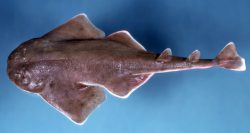select your film:


The Squatine Dimeril Shark, also known as the Atlantic Angel Shark and Sand Devil, is found in the western Atlantic in depths up to 1,290 m. Belongs to the Squatinidae family.
Biology:
A ray-shaped shark, its head is narrowing to a distinct neck at the base of pectoral fins.
Size at maturity in females is reached at around 90 to 105 cm TL, and for males ranges from 92 to 107 cm TL. This species can reach a total length of up to 152 cm.
Reproduction:
Their reproductive mode is aplacental viviparous with only the left ovary functional. Pupping occurs in June or July with pups measuring 28 to 30 cm TL at birth. Litters contain up to 25 pups and the birth usually occurs in depths of 20 to 30 m. Embryos feed solely on the yolk.
Habitat:
This species is found seasonally in shallower water. Off the eastern United States, it appears to move inshore in the spring and summer and disappears into deeper water in other seasons. The Squatina Dumeril is often found in deeper waters where shrimp trawling effort is low.
Behaviour:
The Atlantic Angel Shark feeds of small bottom fishes such as flounders, skates and others. They also eat crustaceans and molluscs. They tend to bite when captured and can inflict serious lacerations with its trap-like jaws and pointed teeth.
Conservation:
In the Gulf of Mexico, the Angel shark occurs with relative frequency as bycatch in trawl fisheries targeting butterfish and it is possible as bycatch in other fisheries.
In Atlantic US waters, Angel sharks are currently listed as prohibited under the federal management for Atlantic tunas, swordfish and sharks, as a precautionary management measure.
Do you have images or videos of Atlantic Angelsharks?
Submit them to [email protected].
